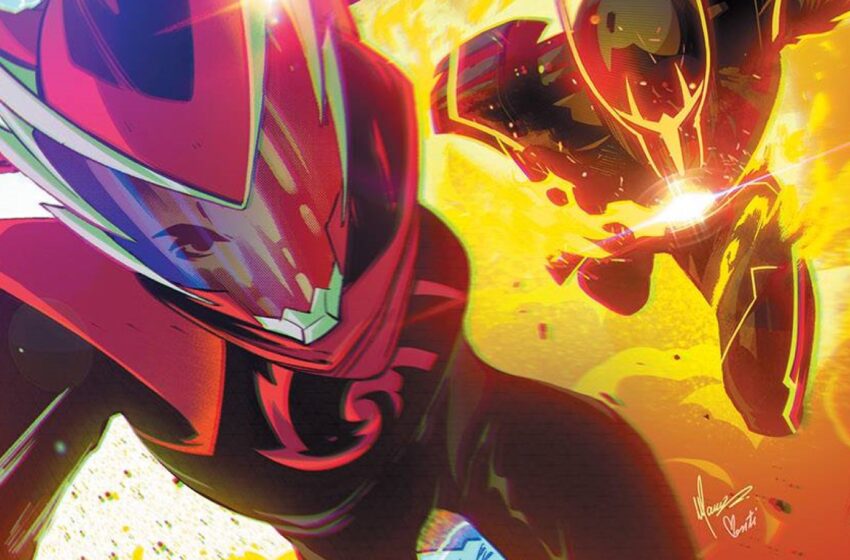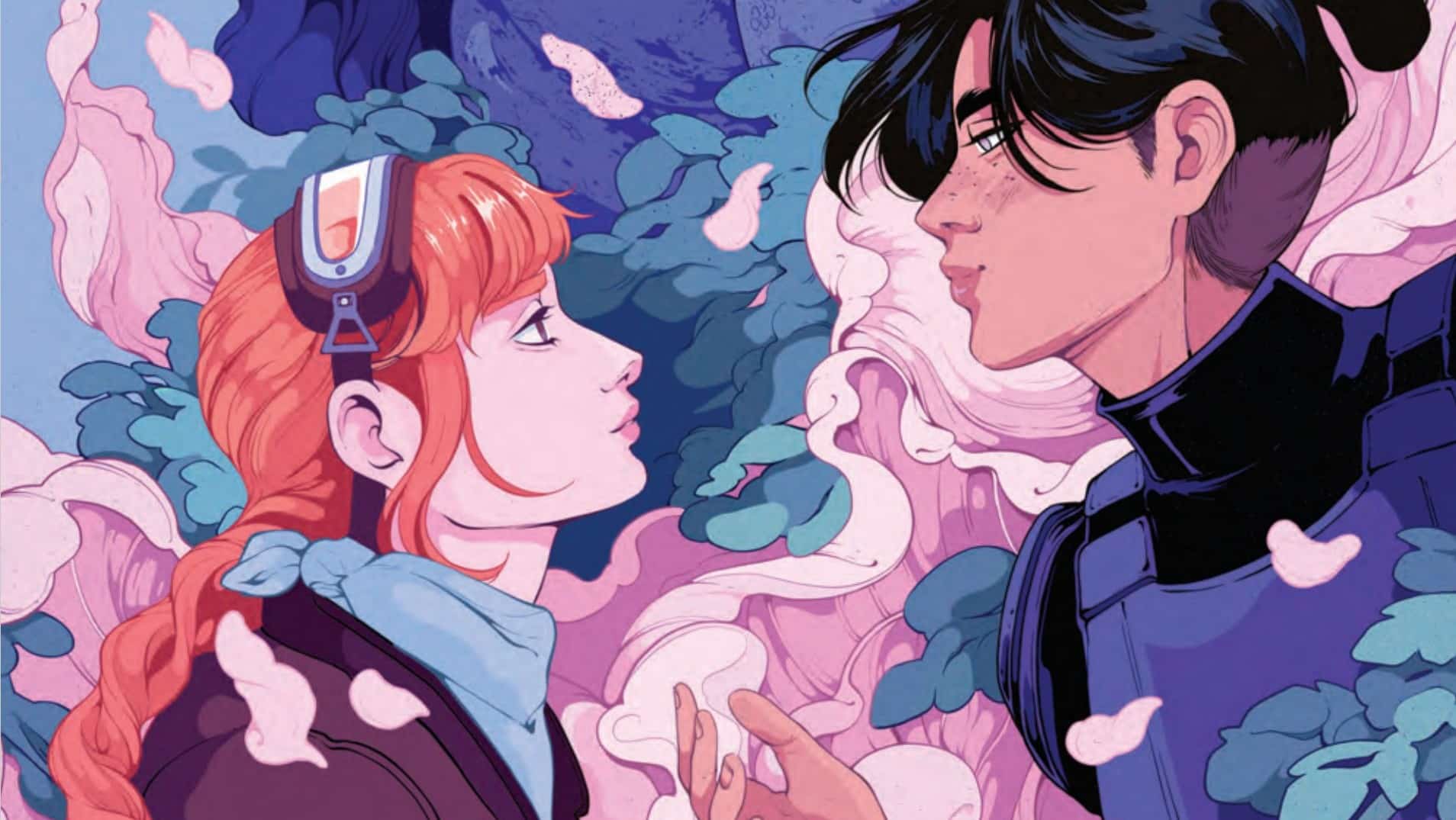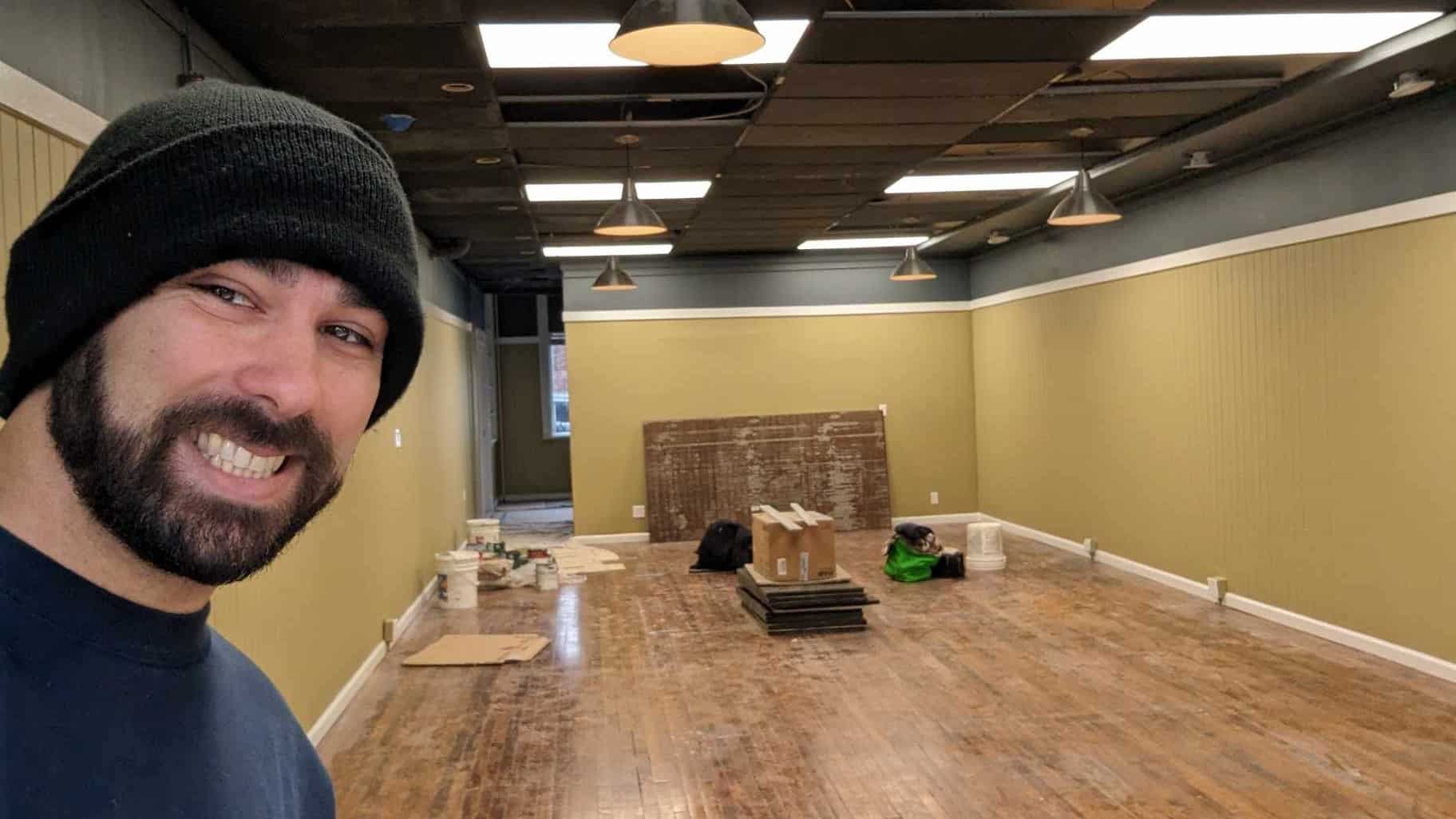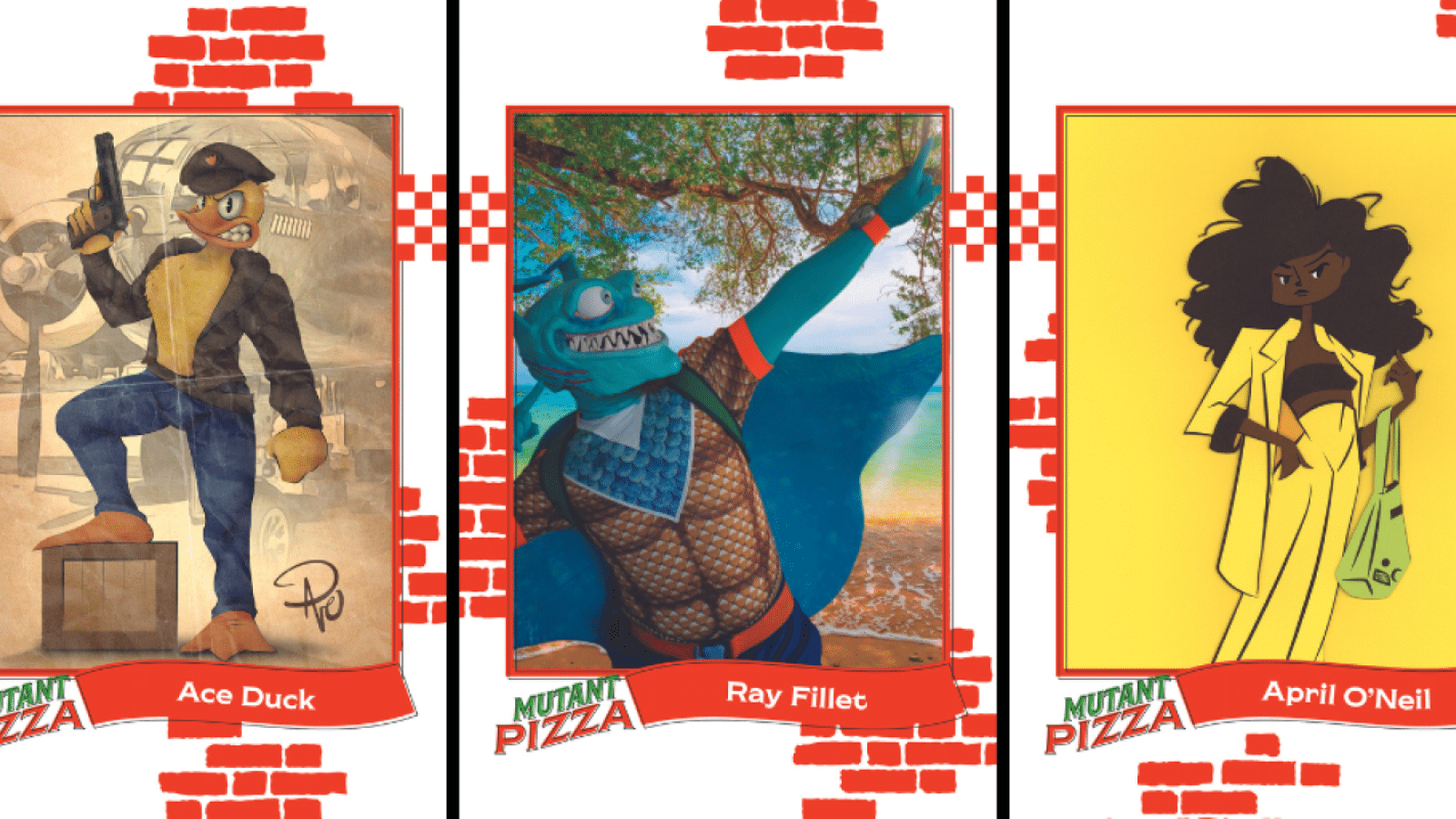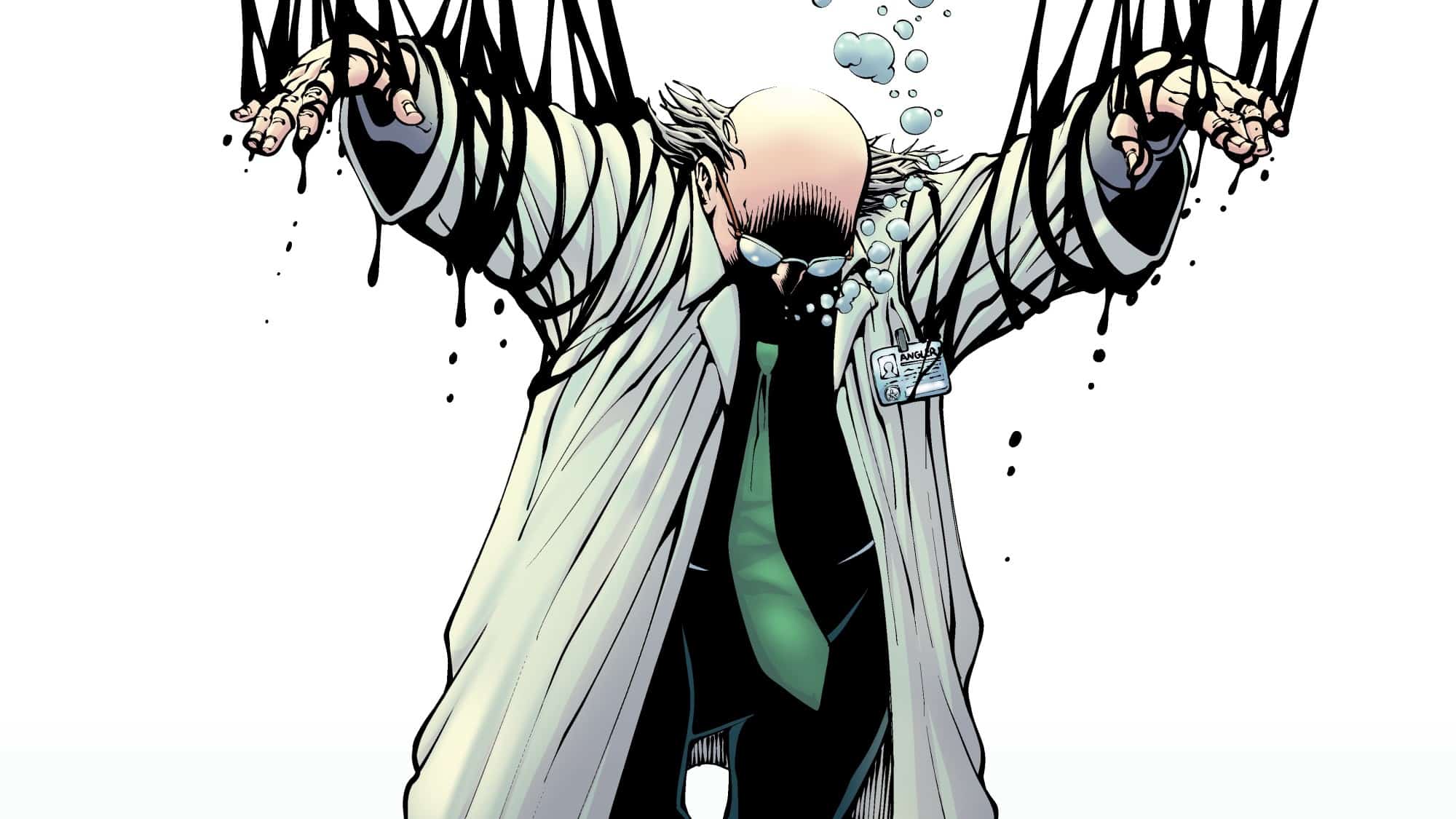In December, ComicsXF’s intrepid head honcho, Zachary Jenkins, hit the floor of C2E2 with a microphone in his hand and a hankering to talk to as many creators as he could get five minutes alone with. Over the next few weeks, we’ll be sharing some of those interviews.
Thirty years ago, Image Comics introduced the world to creator-owned superheroes like Spawn, Savage Dragon, Shadowhawk and some others whose names probably didn’t start with S.
Now, as it celebrates its pearl anniversary, the publisher is betting on superheroes once again, this time in the form of an expanding line of books by creators with a whole heckuva lot of Power Rangers and Ultraman in their resumes.
What started last year with Kyle Higgins and Marcelo Costa’s Radiant Black is expanding this month with Supermassive, a one-shot event comic intended to tie in last year’s Kickstarter OGN Inferno Girl Red by Mat Groom and Erica D’Urso, and Rogue Sun, a new series by writer Ryan Parrott and artist Abel. The push extends to Image’s anniversary anthology series Image!, the first issue of which features Radiant Black on the cover and a story inside from Higgins and artist Daniele di Nicuolo.
Two of the creators involved, Higgins and Parrott, have been involved with making the Mighty Morphin Power Rangers franchise a force at BOOM Studios. Higgins also recently helped shepherd the Ultraman license at Marvel. Now, they’re building their own world of sentai and tokusatsu-inspired heroes.
ComicsXF caught up with both Higgins and Parrott at C2E2. Check out preview art from some of their upcoming books along the way.
— Intro by Dan Grote
These interviews have been edited for clarity and length, and to update some time elements.
Kyle Higgins
CXF: Do you think your run on Power Rangers with BOOM Studios was the genesis of this boom of tokusatsu-inspired comics, as someone who’s been doing a whole lot of it? Or do you think there are other elements that have made that an attractive type of story to tell in comics?
Kyle Higgins: I think both from a narrative as well as an aesthetic influence, there have been kind of American tokusatsu-themed comics. And I know that’s a pretty broad and a pretty reductive descriptor, but there have been quite a bit of tokusatsu-influenced comics in the market. A lot of them indie. I think though that while Power Rangers certainly … look, the Power Rangers comics in the way that we did it and the way that we rolled out was something that I was very purposefully designing in the spirit of the original Power Rangers. And I don’t mean from a trying-to-write-the-show standpoint. What I mean is that the adaptation takes some of the staples of the transforming-hero archetype from tokusatsu and the team component of Super Sentai and brings that in 1993 and brings in very Western California teenagers and high school drama. So that, that filter that all of that got put through, for an entire generation of us who’re in their 30s, it was so massive, you couldn’t escape it. So, yes, there is a cultural awareness of tokusatsu from a broad societal standpoint, thanks to Power Rangers. So when you’re doing a comic, I looked at that and said:
How do we do this but the comics version of that? It has nothing to do with writing the show or capturing the show, what it has to do with is initially figuring out, because I wasn’t sure, and none of us were really sure, how much of a market there would be for Power Rangers comics. What the crossover was between comics readers who liked Power Rangers and Power Rangers fans who liked comics. The way I approached was to build it so that it was accessible for both, but really I wanted to use that first arc in particular, or really the first year, to really take the opportunity to teach Power Rangers fans about comics who may not read comics and also to hopefully validate Power Rangers amongst comics readers. And that was a lot of fun! That had its own challenges and its own hurdles. And so I do think that the approach certainly helped take what was already out there and put it on a bigger platform in the way the original show did the same thing for tokusatsu. Much like many people who are fans of Super Sentai and Kamen Rider that I know, they found it because of Power Rangers. Same with me.
But I also think that we are in a … look, readers and publishers and entertainment companies are always looking for something new and different. And so to come in with different stylistic and aesthetic influences than what you see in Marvel/DC superhero stuff does lend a flavor that feels a little more unique. And, I think, a lot more exciting right now. That’s why I think you’re seeing much more proliferation as there is.
CXF: You have your own creator-owned work with Radiant Black, a Kyle-Higgins and Marcelo Costa-owned book. And you have done work with Marvel when they brought the Ultraman IP over to the U.S. How do you approach those three things (including Power Rangers) that have these stylistic roots and a lot of similarities and make them different books when you write ‘em?
Kyle: There’s certainly stylistic and aesthetic overlap with all three. But they really could not be more different, in my mind. Power Rangers was … I like to say I wasn’t writing the show as it existed or as I remembered it existing, but I was writing it as I remember it making me feel. And taking that same spirit and building out this superhero team book for a brand that had never had anything like that, especially in comic books. So my approach was to do a very contemporary modern team superhero book with all of that high school clique drama and all of the giant robots that you would want to see with a concept like Power Rangers, but maybe the budget of the show never really fully allowed for.
Ultraman is the original. Ultraman kicked off everything. And there is such a … everything that has to do with Ultraman, and this is not to say I didn’t take this approach with Power Rangers, but everything that has to do with Ultraman that Mat [Groom] and I have built and iterated comes from such a place of respect and admiration. The tenets and the values that the Ultras kind of teach and believe in are ones that I personally find very calming and fulfilling. The Ultras aren’t here to save us, the Ultras are here to help us become the best versions of ourselves. And they don’t wanna get involved in human problems. There’s definitely a much more soulful approach we take with Ultraman than a book like Power Rangers.
And then Radiant Black is a book that exists because of those other two. So much of Radiant Black is about, for me, is it’s not only trying to tell a really really cool contemporary surprising superhero epic, but it’s also a book looking to celebrate being a fan of superheroes. And so there’s a metaness to it, and there are nods to Power Rangers, and we have nods to … one of my favorite bits is in #8 wherein they end up in Tokyo for a bit, and as they fly away, two people look at each other on the street and say “What Sentai is that?” and the other guy just shrugs like, “I don’t know,” so stuff like that. All the Marvel stuff, the Marvel Cinematic Universe, all of that exists in the world of Radiant Black, like it’s in their pop culture as well. So to me they’re quite different, but yes, there’s quite a bit of overlap aesthetically.
CXF: Now, with Radiant Black, you’re about to go into a big explosive event-style crossover style thing that you’re going to be doing with Ryan Parrott. What can you say about that? What can you tell folks?
Kyle: So Supermassive is a 54-page one-shot crossover event special debuting on the 30th anniversary of Image Comics. It’s co-written by myself, Ryan Parrott and Mat Groom. Ryan is bringing his brand-new superhero Rogue Sun that he’s co-created with the artist Abel, and Chris O’Halloran on colors. It’s a series that launches out of Supermassive, so Ryan’s bringing Rogue Sun to Supermassive. Mat along with Erica D’Urso co-created Inferno Girl Red, which we did as a Kickstarter earlier [in 2021] that was quite successful. I’m the editor on that book, so Inferno Girl Red will be debuting in Supermassive, in advance of her own book coming out later this year in 2022.
I said in the press release that the best part of making comics is collaboration, but my favorite part of it is collaborating with friends. Ryan and I have known each other since college. His first work in comics was on issues 3 through 5 of Gates of Gotham over at DC. So the fact that we were both on Power Rangers at the same time was a fun coincidence that allowed us to build something that we used to dream about. The idea of an event that we could shepherd and build out was, we felt, a once-in-a-lifetime opportunity. So that we’d be able to do that again, but with characters that we created, own and control, means so many more things can happen. Again, with Mat coming in as well, and Mat and I co-writing on Ultraman, this really is just a group of friends having the most fun in their careers.
CXF: Now, last question for ya. I’ve been noticing that you’ve been doing at your booth a whole lot of branding and pushing of “Hey, this is that book!” You’ve got the blacklight sticker going out there, you’ve got the logo and icons. What was the impetus behind that? And do you think that has worked to solidify this as a book and as a brand to some of your readers?
Kyle: I don’t know. That’s not something necessarily for me to answer. It’s just something I’ve always wanted to do, and I don’t really know how to take small swings, especially on a creator-owned book. I think it’s why to this day I have such mixed feelings about a lot of my work at DC. Particularly my Nightwing run. I feel that there were some … it’s like stepping up to the plate and you know a fastball is coming, and the bases are loaded, and you know you can smack this thing outta the park, but the third base coach is telling you to take the pitch. Y’know? With something like Radiant Black however, while the book is not about me, there is a lot of me in the book. I wanted to try and do things differently. This is a really personal project and something I’m very passionate about, and everyone who’s working on it is very passionate about. And in so many ways, so many of us feel like everything in our careers has led us to this, being able to make this book together and fire on all cylinders like we do.
And so with that … honestly, so much of what you’re talking about, like branding stuff or blacklight signatures, the blacklight issue, it truly just comes from a place of excitement. It’s just the stuff I love, and the stuff I love doing. I said on a panel today that I have never been more creatively fulfilled than I am right now doing Radiant Black, and I mean it, because there are all these parts of my personality and my life, including my work, that a lot of people don’t even know about. And now I get to stretch those muscles a bit. Like, I was in post-production for years, I was a sound editor for 10 years. I came up as a video editor, I used to work as a … but yeah, you get it. But to go apply all of that to go animate trailers, to do glitch graphics, the website with Michael. Michael is this other amazing compliment to all this, Michael Busuttil, our editor and designer. We lovingly refer to him as The Wizard, because there’s nothing he can’t do. He’s so versatile and so talented at so many things, and so organized and responsible, and that’s the actual real secret as to why we’re able to execute so much of this stuff.
It’s really just all coming from a place of love, and I have to say that it’s been a very nice weekend here. And it makes me very happy to hear from people how much they’re enjoying the book.
Ryan Parrott
CXF: So Ryan, one of the things that I really appreciated about the relaunch of the BOOM Power Rangers titles starting with Kyle Higgins, and now you’re doing a huge amount of it, is the combination of taking this show that was very cheaply made — and that’s part of the charm of it — it was a show for children cobbled together with footage from a different Japanese show and American footage trying to get it all together. And your mission is to impart the feeling that the show had when you were a kid, not the reality of that show when you go watch it on Netflix with your own kids. How do you go about trying to capture that energy into a comic?
Ryan Parrott: I remember that was sort of the guiding light or guiding direction that Kyle gave me was like — I remember he said early on in an interview that he tried to write the comic book the way that he remembered it, not necessarily the way that it was. I thought it was a great approach, and I really liked that, so I sort of tried to do the same thing. So I actually haven’t gone back and watched, I mean I would go back and watch a few episodes just here and there for consistency to make sure people are who they are and the structure of it all. I think it was Dafna Pleban, who’s our editor, who asked me if I wanted to do Go Go Power Rangers. I thought Kyle was already doing the other book, but she wanted a book to be about being in high school, and I got that. Dafna was thinking about a book that was like 60-70% hanging out with your friends and the problems of normal high school life, and 30% fighting monsters and Putties and all that stuff. So that was the approach, and I could do that.
I looked at Buffy and the way they did it. I always loved the way they took high school problems and personified them into monsters and antagonists. I tried to do the same thing, and when I found that model, it made me realize how much of my high school stuff I wanted to talk about. The whole arc with Matt was based on something that happened when I was in high school. They split the zoning area so half of my friends went to one high school and half went to the other. We’d hang out on weekends, but occasionally and eventually we started splitting up because you have those common things at your high school. What if that was Power Rangers? What if you couldn’t communicate with the others and there was one kid that went to one high school and five that went to the other and you couldn’t tell other people? It’s just about finding all those little things in your life. All of the relationship stuff is from my high school. It’s always about forging your past.
CXF: Now one of the things that you bring up is that Matt was the big character with the big arc in the Go Go Power Rangers era. Was that something that had a bit of intimidation with it regarding there being an established baseline of what Power Rangers is while you’re specifically approaching it without the Green Ranger taking up all the space, which is a classic Power Rangers problem? Was there any intimidation in going in there and screwing with the dynamic of the original Rangers and adding this extra member and a lot more complexity with that? It changes, for good or bad, what was in a lot of people’s minds.
Ryan: What I liked about it was that it brought a whole different dynamic for every character. I liked the idea that it was Kimberly’s first boyfriend. I liked that it was Zack’s best friend from when they were little kids. I liked that he was the center of the group and then to get pulled out I thought made it even weirder. It’s like losing your leader to another school and then you have to wonder who’s going to pick up that energy. I thought that was the perfect time to have that character go through that in the first days of being Power Rangers when everyone is trying to find their own footing. That allowed me to explore that Jason’s going to have to step up and be the leader a little bit, because we never saw that in the show. He was automatically the leader, and it’s way more fun, if you’re going to do an origin story, to ask: What if these people weren’t ready for that? What if Jason was kind of the soft-spoken and quiet one? Then Zordon makes Jason the Red Ranger and the leader and he’s been anointed. So how does he rise to the challenge? Doing those kinds of things I thought was really fun, so for me adding Matt to the balance gave me a lot of story to play with for all of them.
CXF: Now you’ve been on the Mighty Morphin and Power Rangers books you relaunched about a year and a half ago, and you’ve been diving deep into the expanded universe continuity of the Power Rangers. It’s a show that started as a very simple, “After 10,000 years, I’m free. It’s time to conquer Earth.” Very little backstory.
Ryan: Haha, yeah. That number screwed me over a few times too, by the way. Ten thousand years?! Couldn’t have been 200? Come on!
CXF: Exactly, so what was the impetus to take a very simple formula of fighting monsters with some sort of related social issue every episode and turn it into a big lore-based continuity, sprawling, epic story?
Ryan: Well I actually think that — you mentioned earlier when you were talking about how the show was created in such a way that they were using footage from another country and then adding it together. One of the cool things, and this may sound like a diss, but I don’t mean it like that, is that because of the way that Power Rangers was constructed where not many things were explained, there were a lot of random, weird elements. Stuff comes up like they talk about the Morphin eggs in one episode but they never talk about them again, and they talk about the Morphin Masters and never speak about them again. What’s really great about that is they kind of write you into a corner, which is kind of fun sometimes. I am sitting here as a writer, and I have this, this, this and this, but how can I tie them together? How can I build a story about doing that? Sometimes in modern storytelling, you have to plan everything out so that it’s already done, which can take some of the energy and fun out of it because you’re stuck with what you already came up with. With Power Rangers, I can do whatever I want as long as I can connect things. Because it was written mostly for children, and now all of the fans have aged up and are expecting a higher level, anything above the level of being written for children is helpful. The expectations are lower, so as long as I write it for a little more sophisticated audience, and I find a way to honor all of the little pieces, it’s exciting how many people enjoy it. All I did was connect what was already there in a fun way.
CXF: Now, outside of Power Rangers stuff, you have your own sentai/kaiju type of story coming out from Image soon. It’s going to be tied into what Kyle Higgins is doing with Radiant Black. Tell us a little about that. What are you excited to do with this that you can’t do with Power Rangers?
Ryan: That’s a good way to put it. Most people know Kyle and I are good friends. We’ve known each other for years, even before Power Rangers. I was really excited when he announced Radiant Black. It was a Power Rangers-esque comic at Image, and they wanted more than just the main title, so Kyle asked if I was interested. I had an idea, I threw it at him and he was on board. Then he told me that I wasn’t just going to do it in my one book. We’re going to do a giant crossover just to launch the universe. This is the 30th anniversary of Image, and we wanted to go back to what Image did. I am a huge Image kid, and I bought every Image book out there.
I brought a book and an idea. It’s called Rogue Sun, and it’s about a kid who’s a rebellious teenager and finds out that his estranged father was a superhero after he passes and leaves him the mantle. Now he has to become a superhero and, in doing so, learns about the man he hated his entire life. I look at it like a darker version of Batman Beyond a little bit. It’s fun to play with that, and what’s great for me is that I can take what I’ve learned from writing Power Rangers and do it in my own way where I’m not connecting dots as much as I am building them myself. It’s been a really fun experience, and working with Kyle on something like this has been crazy. Just to have a book at Image after being such a huge fan is surreal.
CXF: Yeah! Now the last question for you is that you bring up Radiant Black, and Image has been doing several series like Ultramega by James Harren that plays with the Ultraman, sentai and tokusatsu style. There’s even an actual Ultraman title coming out from Marvel. Why do you think right now between that, the Power Rangers stuff and everything else, is there such a revival in the comics space?
Ryan: I think first is that comics have a great ability for scope and scale that would normally be much more limited in movies and TV with what you can do. Comics can go anywhere, and I feel there’s a bit of a renaissance because you can do comics at the scope, scale and speed for an audience that’s ready for it. It’s a nice combination of being able to do those stories in a medium that is accessible, easy and understood. Also, there’s an appetite that might be there due to the rise of streaming where people have way more access to those types of shows. I think that the audience is growing at the same time. Twenty years ago, there were only so many DVDs and now there’s Crunchyroll and PlutoTV where there’s a whole row that runs it all the time. There’s so many people who finally have access to a ton of seasons worth of material. There’s so much material, and there’s a big audience waiting. Now that it’s all available, I think, is really wonderful. Comics are a great medium, it’s not superheroes. It may have taken us a while to realize that, but we’re finally there.
Radiant Black #12 comes out Feb. 9 (this Wednesday). Supermassive comes out Feb. 23. Rogue Sun #1 comes out March 2.
— Interviews transcribed by Ritesh Babu and Ari Bard

